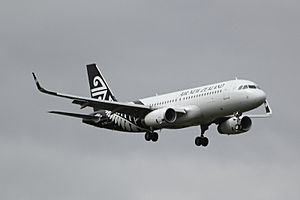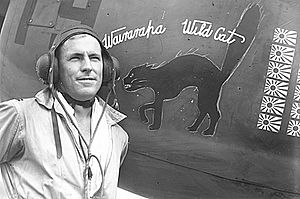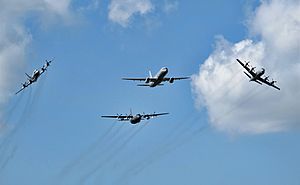History of aviation in New Zealand facts for kids

The history of aviation in New Zealand is all about how flying started and grew in this country. It began in the late 1800s with hot-air balloon flights. In the early 1900s, some clever New Zealanders started building their own flying machines. The first confirmed powered flight in New Zealand happened in 1911, thanks to Vivian Walsh.
The First World War really sped up the development of aviation in New Zealand. A special school was set up to teach people how to fly. Hundreds of New Zealanders then joined British flying groups in Europe. After the war, civil aviation (flying for everyday people) began to grow. Flying clubs became popular in the late 1920s. The first big airline, Union Airways of New Zealand, started flying in 1936. New Zealand also created its own air force, the Royal New Zealand Air Force (RNZAF). During the Second World War, the RNZAF played a huge part in the war effort. Thousands of New Zealanders were trained to fly and served in different parts of the world. After the wars, the RNZAF got modern jet planes and helicopters. The civil aviation industry also kept growing, with Air New Zealand forming in the 1960s.
Contents
Early Days of Flight
New Zealand saw its first hot-air balloon flights in 1889. In 1894, a young American woman named Leila Adair amazed crowds by parachuting from a hot-air balloon. Sadly, the first recorded death in New Zealand aviation happened in 1899. David Mahoney, also known as 'Captain Lorraine', died when his balloon was blown out to sea near Lyttelton.
First Powered Flights
Several New Zealanders worked hard to build and fly planes in the early 1900s. Richard Pearse, working by himself in South Canterbury, built a monoplane (a plane with one set of wings). He might have tried flying as early as 1901. There's some debate that he made a short powered 'hop' in 1903, even before the famous Wright Brothers.
Herbert Pither built a plane in 1910, but it seems he couldn't get it to fly for long. Arthur Schaef made short powered hops in his plane, the New Zealand Vogel, in 1911. The engine from his plane was later used by Percy Fisher for successful flights in 1913. The first confirmed powered flight in New Zealand was made by Vivian Walsh in 1911. Vivian and his brother Leo brought a Howard Wright biplane (a plane with two sets of wings) to New Zealand. Vivian flew it at Papakura on 5 February 1911.
Aviation During World War I
The First World War (1914-1918) greatly boosted aviation in New Zealand. The Walsh brothers started the New Zealand Flying School in Auckland. They used flying boats to train over 100 pilots. Henry Wigram set up the Canterbury Aviation Company in Christchurch. This company imported and built planes, training 182 pilots.
About 800 New Zealanders joined British flying groups like the Royal Flying Corps during the war. Most of them were aircrew. Another 60 New Zealanders served with the Australian Air Corps. Twelve New Zealanders became squadron leaders, and fifteen were known as aces (pilots who shot down five or more enemy planes). Famous aces included Keith Park and Keith Caldwell. William Rhodes-Moorhouse, who had New Zealand parents, was the first airman to receive the Victoria Cross, a very brave award.
Growing Civil Aviation
After the war, rules for civil aviation were made in 1919. These rules covered things like registering aircraft and licensing pilots. Flying clubs became popular in the late 1920s, and the government helped by providing some training planes. Commercial flying also started in the 1920s, though some early companies didn't last long.
First Major Airline
The first big airline was Union Airways of New Zealand. It started flights in 1936 between Palmerston North and Dunedin. By 1939, the company was flying between many major cities like Auckland, Wellington, and Christchurch.
Flying Across the Tasman Sea
People started trying to fly across the Tasman Sea (between New Zealand and Australia) in the late 1920s. John Moncrieff and George Hood sadly disappeared during an attempt in 1928. Later that year, Charles Kingsford Smith and his team successfully flew from Sydney to Christchurch. More Tasman flights followed. By 1940, Tasman Empire Airways Limited (TEAL) began regular flights. TEAL was owned by several airlines and the New Zealand Government. TEAL and Pan Am also developed flying boat services across the Pacific Ocean to the United States.
Royal New Zealand Air Force (RNZAF)
After the First World War, New Zealand received many extra military planes from the United Kingdom. The New Zealand Permanent Air Force was set up in 1923 as part of the New Zealand Army. Bases were built at Wigram in Christchurch and Hobsonville in Auckland.
In 1936, a British group suggested changes, leading to the creation of the separate Royal New Zealand Air Force (RNZAF) in 1937. New planes were ordered, and bases were built at Ohakea and Whenuapai. This showed the government's new focus on air defence.
World War II and the RNZAF
When World War II started in 1939, the RNZAF was waiting for 30 Vickers Wellington bomber planes. These planes, along with their crews, were given to the United Kingdom and became No. 75 Squadron RAF. New Zealand became a major source of aircrew for the British Royal Air Force (RAF) through the Empire Air Training Scheme. The RNZAF itself grew hugely, with over thirty squadrons. Many of these squadrons saw action in the Pacific.
Many New Zealanders had successful careers in the RAF. Keith Park led the important No. 11 Group during the Battle of Britain. Aces during the Battle of Britain included Edgar Kain and Alan Deere. Arthur Coningham led the Desert Air Force and later the 2nd Tactical Air Force during the Normandy landings. New Zealand pilots were awarded three VCs (Victoria Crosses) for their bravery: James Allen Ward, Leonard Trent, and Lloyd Trigg. In the Pacific, RNZAF aces included Geoff Fisken.
Post-War Civil Aviation
After the war, new ways of using planes were explored. There had been some tests with aerial topdressing (spreading fertiliser from planes) in the 1930s. This continued after the war, mainly using Tiger Moth planes. Special planes were developed for this, like the Fletcher Fu24.
TEAL (Tasman Empire Airways Limited) kept its flights across the Tasman Sea during the war. After the war, its flying boats flew the "Coral Route" to Tahiti, stopping at Fiji, Samoa, and the Cook Islands. This service ran from 1951 to 1960. TEAL became fully owned by the New Zealand government in 1961 and changed its name to Air New Zealand in 1965.
National Airlines
Union Airways joined the government-owned New Zealand National Airways Corporation (NAC) in 1945. NAC took over other private airlines and expanded flights all over New Zealand. NAC used planes like the Douglas DC-3, Vickers Viscount, and Boeing 737.
Straits Air Freight Express (SAFE Air) started in 1950. It was a special company for carrying freight across Cook Strait, using Bristol Type 170 Freighter Mk.31 planes. NAC bought SAFE Air in 1972. Later, NAC merged with Air New Zealand in 1978. This created one big government-owned airline for both domestic (within New Zealand) and international flights.
Post-War RNZAF
After World War II, RNZAF units were sent to Japan, Cyprus, and during the Malayan Emergency. The RNZAF got jet aircraft like the de Havilland Vampire and the English Electric Canberra. They used Short Sunderland planes for patrols over the sea. Transport squadrons flew planes like the C-47 Dakota and the Bristol Freighter.
In the 1960s, the RNZAF got many new planes. These included the A-4 Skyhawk fighter jets, P-3B Orions for maritime patrols, C-130 Hercules transport planes, and UH-1 Iroquois helicopters. In the early 2000s, New Zealand stopped using jet fighter aircraft when the Skyhawks were retired and not replaced.
Images for kids




